Upload a Custom Indicator
In case you want to use a custom indicator, instead of using a standard indicator, you can upload the indicator. There are 2 paths to upload a custom indicator:
- When adding an indicator to your EA.
- At the ‘My Indicator’ page, which you can find in the menu.
We support custom indicators in both the mq4/ mq5 (mql)- and ex4/ ex5 (ex) format.
Once you’ve uploaded your indicator and processing is ready, you can proceed by selecting ‘Next’ in the list of indicators.
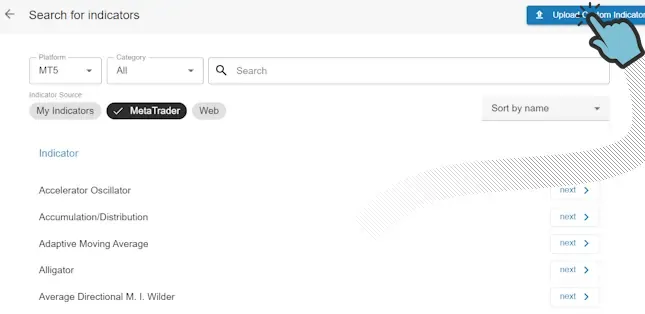
When uploading a custom indicator results in an error
Section titled “When uploading a custom indicator results in an error”If the indicator fails to analyze, please double-check that you’ve uploaded the correct file. If the issue persists, feel free to contact us. Please note that a subscription is required to upload Market place indicators. This is because we manually process these indicators for you, once we’ve received your request
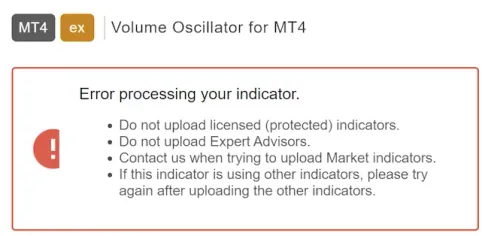
Finished Uploading a Custom Indicator
Section titled “Finished Uploading a Custom Indicator”If all went well, you’ve successfully uploaded your custom indicator. Chances are you’ve already used it in MetaTrader. If not, take some time to do so and familiarize yourself with your indicator. Pay special attention to the important Mode parameter almost every indicator shows after uploading.
The Mode Parameter
Section titled “The Mode Parameter”If your custom indicator has one or more values (lines/ arrows/ etc.), it’s crucial to use the one(s) you want to use in your EA. To do this, you must select the correct Mode. For you to find the correct Mode, we’ve created a complete and detailed plan we recommend following. Please note that in this example we’re using an arrows indicator. The same plan must be followed for any type of indicator (histogram, line, color, etc.), as the process is exactly the same.
We’re first going to see if the modes were automatically detected by our tool when uploading your indicator. Click on your indicator and select the ‘Modes’ tab in the right tool bar. When detecting modes succeeded, you will see something similar to the image below. If the below image matches with what you see, consider Plan A to find your modes. If plan A doesn’t work, you’ll be directed to plan B. It’s possible that the modes have already been named for you, as our system may have recognized the indicator. If this is the case, please ensure that the mode names correspond to the values you use on your charts. If they do, there’s no need to follow a specific plan to identify your modes; you can proceed directly to setting up the signal.
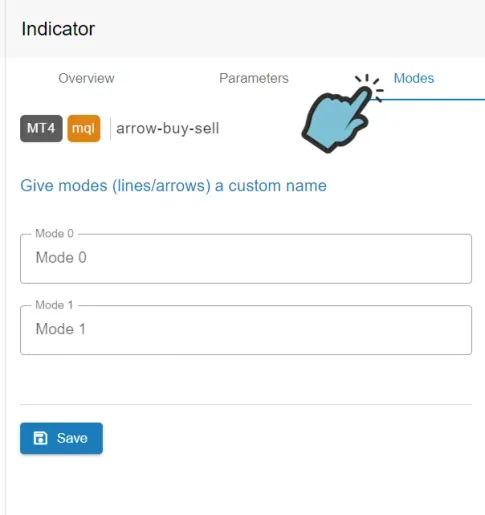
When detecting modes automatically failed, you will see something similar to the image below. If the below image matches with what you see, consider Plan C to find your modes.
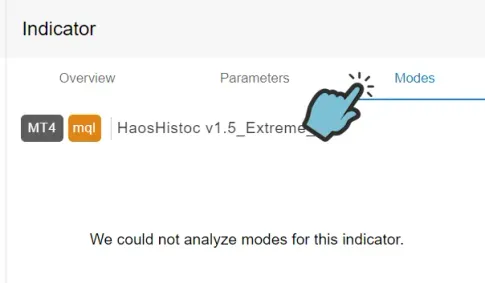
Plan A: When Finding Modes Succeeded
Section titled “Plan A: When Finding Modes Succeeded”If our tool was able to sucessfully detect you indicator’s modes, the next step is to find which of the modes is the one you want to use. With a bit of luck this is very easy. Otherwise, we’re going to need to do a bit more work. So, when ‘lucky’ the number of modes in MetaTrader equals the number of modes analyzed by our tool. To see the modes in MetaTrader, open the Data Window (CTRL + D). Here’s an example of an indicator with 2 modes visible in MetaTrader and 2 modes found by our tool.
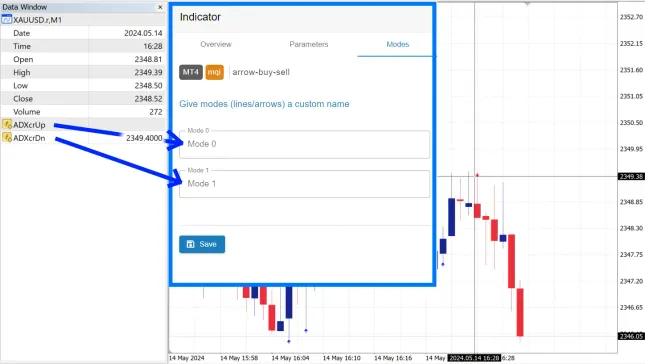
In the above image we have 2 modes. One mode contains the values of the Up arrows and one mode contains the values of the Down arrows. We can find which of the 2 modes is the Up or Down arrow by hovering our mouse over an Up or Down arrow on the chart and observing which of the 2 modes in MetaTrader’s Data Window presents a value. If the first mode presents a value when hovering our mouse over the Up arrow, we know the first mode (Mode 0) are the Up arrows. Now, also hover over a Down arrow to verify the 2nd mode contains the Down arrows. If it does, then now you know the 2nd mode (Mode 1) are the Down arrows.
In the image above you can see that when hovering over the down arrow, the Data Window shows a value for the 2nd mode of the found modes (value ‘2349.4000’). The same will happen for the Up arrows, which will display a value on the first mode (Mode 0).
To make things easier when building your EA, make sure you rename your Mode 0 and Mode 1 to ‘Up arrow’ and ‘Down arrow’ respectively.
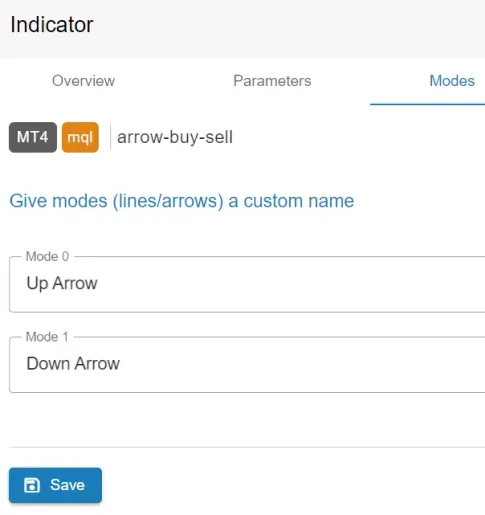
You’re now finished adding your indicator and you can proceed to set up the signal.
If the number of modes found by our tool doesn’t match the number of modes you find in the Data Window in MetaTrader, then you’re going to use a free tool to find out which mode contains your Up and Down arrows. Follow Plan B to do this.
Plan B: Find the Correct Modes Using the Buffer Reader
Section titled “Plan B: Find the Correct Modes Using the Buffer Reader”Open the Market Place in MetaTrader and search for the EA called ‘Buffer Reader’ (MT4) or ‘Buffer Reader for MT5’. Install this EA. Now apply the EA to your chart. Enter the name of your indicator, without the ‘ex4’ or ‘ex5’ extension and export the data. If you get an error, make sure you made no typing error and that your indicator is in the ‘Indicators’ folder and not some sub-folder, like ‘Examples’, ‘Market’ or any other folder.
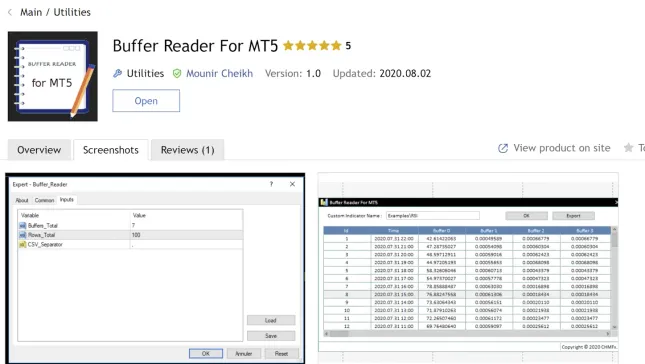
Now open the exported data in Excel, which you can find by going to your MetaTrader Folder (Ctrl + Shift + D, ‘MQL4/5’, ‘Files’). You’ll now see all the values of your indicator. The first 2 columns represent the row number and timestamp. The subsequent columns correspond to your indicator’s ‘Buffers’ which represend the mode number you’re looking for. By examining the data in Excel, you can determine which row contains the values for each bar, identified by timestamp. This allows you to identify which column (mode) contains the value of your arrow. Once you locate the value in the Excel sheet, you’ll know which Mode corresponds to your arrow.
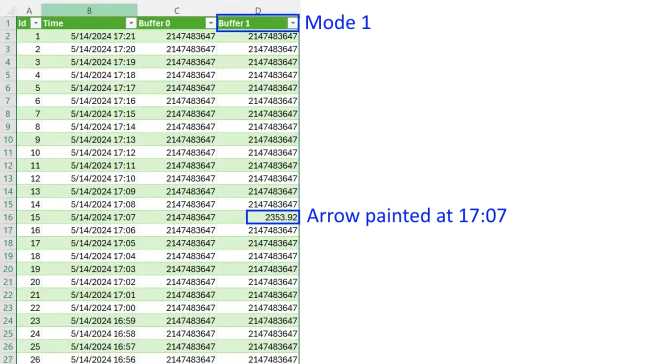
To make things easier when building your EA, make sure you rename your Mode 0 and Mode 1 to ‘Up arrow’ and ‘Down arrow’.

You’re now finished adding your indicator and you can proceed to set up the signal.
Plan C: Finding Modes using the Buffer Reader
Section titled “Plan C: Finding Modes using the Buffer Reader”If our tool couldn’t successfully detect your indicator’s modes, the next step is to try to find them manually. It’s also possible that the indicator doesn’t contain any modes. In such cases, the indicator cannot be used for automation and another, similar, indicator must be found.
Open the Market Place in MetaTrader and search for the EA called ‘Buffer Reader’ (MT4) or ‘Buffer Reader for MT5’. Install this EA. Now apply the EA to your chart. Enter the name of your indicator, without the ‘ex4’ or ‘ex5’ extension and export the data.

Now open the exported data in Excel, which you can find by going to your MetaTrader Folder (Ctrl + Shift + D, ‘MQL4/5’, ‘Files’). You’ll now see all the values of your indicator. The first 2 columns represent the row number and timestamp. The subsequent columns correspond to your indicator’s ‘Buffers’ which represend the mode number you’re looking for. By examining the data in Excel, you can determine which row contains the values for each bar, identified by timestamp. This allows you to identify which column (mode) contains the value of your arrow. Once you locate the value in the Excel sheet, you’ll know which Mode corresponds to your arrow.

Now we know which modes you want to use, go ahead and add your indicator to your EA. Make sure you rename your indicator so that you know which value this indicator contains. For example if you indicator file is called ‘Haos’, then you can rename the indicator to ‘Haos Up’ and set your Mode to value 0. Now add the same indicator (‘Haos’) to your EA again and rename the indicator to ‘Haos Down’ and set your Mode to value 1.

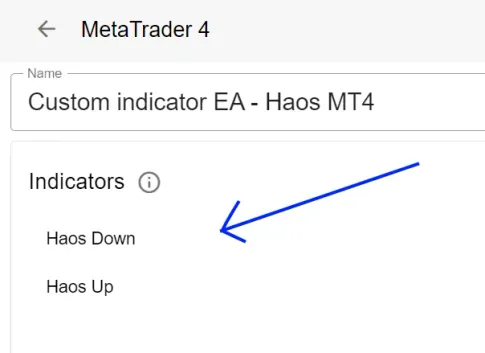
You’re now finished adding your indicator(s) and you can proceed to set up the signal.